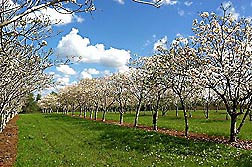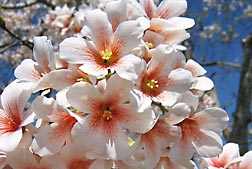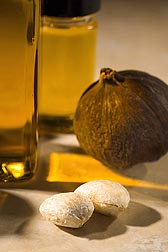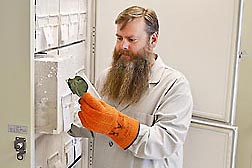New Ornamental Tung Tree a Story of Loss and Restoration
|
|
The newest tung tree on the scene, Anna Bella, may herald a new generation of ornamental tung tree varieties suitable for landscape uses in the U.S. Gulf Coast.
From the late 1920s to early 1970s, nut-producing tung trees had been grown commercially on plantations across the region as the source of a prized fast-drying and waterproofing oil for paints, varnishes, lacquers, wood finishes, and other industrial products. A convergence of factors ultimately scuttled the tung oil industry there, but nostalgia for Vernicia fordii, as the native Chinese tree is known scientifically, has lingered to this day.
“At one time there was ‘tung tourism,’ where folks came to the Gulf Coast for the beaches and to drive through the tung orchards,” says Timothy Rinehart, a molecular geneticist at the Agricultural Research Service’s Thad Cochran Southern Horticultural Research Laboratory in Poplarville, Mississippi. “People still plant tung trees in their yards around here—sometimes as an homage to their childhood, when tung was grown everywhere, and sometimes just because of its beauty.”
What makes Anna Bella unique as an ornamental variety is that it is sterile and produces virtually no nuts, which are toxic if ingested (as are the leaves) and pose a mowing hazard if left on the ground.
|
|
“The downside to planting tung in the backyard has been the nuts, so we thought a nutless tree would be a great solution,” Rinehart explains. “This release was also driven by the desire to preserve some of the history of tung before it was lost, to publicly acknowledge ARS’s involvement in tung production in the region, and to give specialty nurseries an additional flowering tree for use in the South.”
Indeed, the Poplarville laboratory had originally been known as the “USDA Tung Oil Research Station”—a reflection of its commitment to providing commercial tung tree growers in Mississippi, Florida, Louisiana, and other Gulf Coast states with new varieties that offered high yield, frost tolerance, and other desirable traits.
U.S. Tung Oil Industry: Bright but Brief
In its heyday, circa 1945, the U.S. tung oil industry had nearly 10 million trees in production—with mills strategically located across the Gulf Coast that specialized in extracting oil from the seed and processing it further for use, including to coat ammunition during World War II. By 1971, however, the laboratory had redirected its research to small fruits production. This shift was a consequence of an industry overwhelmed by the forces of economics (competition from abroad as well as other oilseed crops) and nature—in the form of Hurricane Camille, which in 1969 destroyed about half of the Gulf region’s commercial groves.
The station’s tung germplasm collection survived, however, and has been maintained ever since. It includes unreleased cultivars with a trait known as “late-flowering,” which commercial tung growers desired as a way to avoid costly, bloom-killing spring frosts.
|
|
A New Lease on Life?
“A few years ago, we went through the collection and really opened our minds regarding what beneficial uses these trees might have—looking for new life in the collection, so to speak,” says Rinehart of initial examinations by colleagues Ned Edwards and James Spiers (retired). “We dug out all the old breeding records, pedigrees, and research publications to make sure we knew what we had.”
They came across one tung germplasm line—Anna Bella—that had originally been collected in the 1950s from an unknown source for the late-flowering trait. A lack of records on it led the team to believe it had never been used commercially because of its sterility. However, the researchers were intrigued by the ornamental prospects of this trait, and Rinehart coordinated multistate evaluations with university cooperators to examine Anna Bella’s other growth characteristics.
The results were encouraging, so they released the variety “as is” in 2012 and reported its development in the January 2013 issue of HortScience.
The tree variety, which is adapted to conditions in the South, can reach nearly 40 feet tall and opens into an umbrella-shaped canopy of lush, heart-shaped leaves. It blooms in late spring, producing clusters of long-lasting white flowers, tinged in the centers with yellow or red. Anna Bella requires little maintenance, bounces back well from pruning, and can withstand common insect pests and diseases.
|
|
It is ideal for both single-specimen and row plantings, such as in backyards and along roadsides or property boundaries, the researchers say. And because it produces no seed, the variety is unlikely to become “naturalized,” or spread beyond intended planting sites—a characteristic the researchers hope will encourage wider acceptance of the tree species as an ornamental offering.
Rinehart has already received requests from a few specialty nurseries interested in propagating the variety from budwood material and a few hundred “mother plants.”
“Since we’ve started working on Anna Bella, we’ve been contacted by folks interested in restarting commercial tung oil production in the Gulf Coast region for biofuel and industrial uses,” he reports. “After meeting with them to discuss their needs, we identified another tree in our collection that we hope to release as a commercial cultivar.”—By Jan Suszkiw, Agricultural Research Service Information Staff.
This research is part of Plant Genetic Resources, Genomics, and Genetic Improvement, an ARS national program (#301) described at www.nps.ars.usda.gov.
Timothy Rinehart is in the USDA-ARS Thad Cochran Southern Horticultural Research Laboratory, 810 Hwy. 26 West, Poplarville, MS 39470; (601) 403-8766.
"New Ornamental Tung Tree a Story of Loss and Restoration" was published in the April 2014 issue of Agricultural Research magazine.










